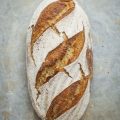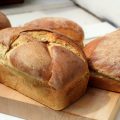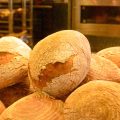Before a sourdough loaf is complete it must go through the shaping process, to ensure that it has sufficient tension and a good gluten structure in order for it to be deemed “the perfect loaf.” A batard sourdough shape is just one of the many shaping techniques used to bake wonderful loaves. Read on for the ultimate guide.
![Batard Sourdough Shaping [Your Ultimate Guide] 1 Batard sourdough shaping [the ultimate guide]](https://www.mydailysourdoughbread.com/wp-content/uploads/2022/12/CD-blog-images-2023-01-05T195459.693-720x405.jpg)
Table of Contents
- What is a Batard?
- How to Shape a Batard?
- Batard Shaping Tips
- Why is Shaping Important in Bread Baking?
- Batard Shaping Sourdough
- Batard Sourdough Shaping – FAQs
What is a Batard?
Batard is a French term for an oval or oblong-shaped loaf. Batard shaping is bread dough that has been shaped into a football-like oval, with sharp or blunt ends.
How to Shape a Batard?
Take your pre-shaped dough, and lightly dust the top of the dough with flour. Use your bench knife to flip the dough onto a clean work surface, so that the un-floured section is now the top.
Below are two methods of shaping a batard:
Method 1
Lightly flour the surface before placing your dough on the kitchen counter.
- Fold the bottom of the dough up and into the center. Next, fold the top half down into the middle, pressing down lightly with your fingertips to seal. Your dough should look like a rough-shaped oval. Rotate the oval-shaped bread dough so that it is laying vertically.
- Repeat the folding process with the remaining sides, so that all the edges are tucked into the middle, and your dough is now a nice oblong shape.
- Gently lower your oval shape dough into an oval proofing basket (or basket alternatives) for the final proof!
Method 2
This method is a tad complicated compared to the first one but creates an oval loaf with more tension in its shape.
- Start by lightly flouring the top of the dough, then flip it onto your work surface; the non-floured side facing up. Fold the top and bottom sides of the dough into the center.
- Rotate the dough so that it is lying vertically. It should appear wider at the top, compared to the bottom. Pinch the bottom of the dough to create a narrow tail, then roll the dough straight until you reach the end.
- Fold the right and left sides of the dough so that they meet in the middle, then use your hands to seal the dough. Flip and tuck the bottom seam under. You should have an oblong-shaped batard with lots of tension to hold its shape.
Gently lower your shaped batard into a lightly floured banneton seam side up for its final proof.
Batard Shaping Tips
Make sure you’re using enough flour on the work surface and your hands to prevent the dough from sticking to the kitchen counter.
While some shaping methods prefer to have the dough sticking to the work surface, to create good surface tension, this isn’t the case for batard shaping. If you find the dough sticking to your work surface at any point, simply stop and add a light dusting of flour beneath the dough to help prevent it from sticking to the work surface.
Ensure the dough has rested after pre-shaping so that it’s prepared for the final shaping steps. If the dough feels very tight and elastic, then let it rest for 10 more minutes before checking again. The gluten should be relaxed. And for this to work, you’ll need to let the dough spread out on the work surface so that shaping it becomes easier. If the dough is too tight, it’ll be hard to stretch, fold and roll the dough.
Make sure you’re gentle with the dough, as condensing it too much can jeopardize the open crumb we desperately need.
![Batard Sourdough Shaping [Your Ultimate Guide] 2 Batard sourdough shaping [the ultimate guide]](https://www.mydailysourdoughbread.com/wp-content/uploads/2023/01/CD-blog-images-2023-01-05T195657.420-720x405.jpg)
Why is Shaping Important in Bread Baking?
Shaping bread dough is extremely important when it comes to bread baking. Not only does it help create a final appealing shape to your dough, but it also gives the dough sufficient tension and structures it needs for the perfect oven spring. This is especially important for batards as well as achieving a nice ear.
The surface tension created through shaping enables the bread to maintain its shape whilst expanding in the oven. The quality of the final shape will determine the outcome of the baked bread, in terms of the structure and crumb.
Batard Shaping Sourdough
A batard-shaped loaf is probably one of the simplest and most rewarding shapes to go for when it comes to sourdough bread. For more on sourdough bread shapes, try our sourdough baguette article for a fantastic sourdough French loaf!
Batard Sourdough Shaping – FAQs
What is The Difference Between a Baguette and a Batard?
A batard is shaped similarly to a baguette, the only difference between the two is that baguettes are shaped very long, whereas the batard is shaped much shorter.
What is the Difference Between a Boule and a Batard?
The difference between a boule and a batard is the shape. A boule is a round-shaped loaf, while a batard is torpedo-shaped. In the end, both are deliciously crusty French bread.





![How To Cold Proof Sourdough [Your Easy Guide] 7 How to cold proof sourdough [your easy guide]](https://www.mydailysourdoughbread.com/wp-content/uploads/2023/01/blog-images-40-120x120.jpg)
